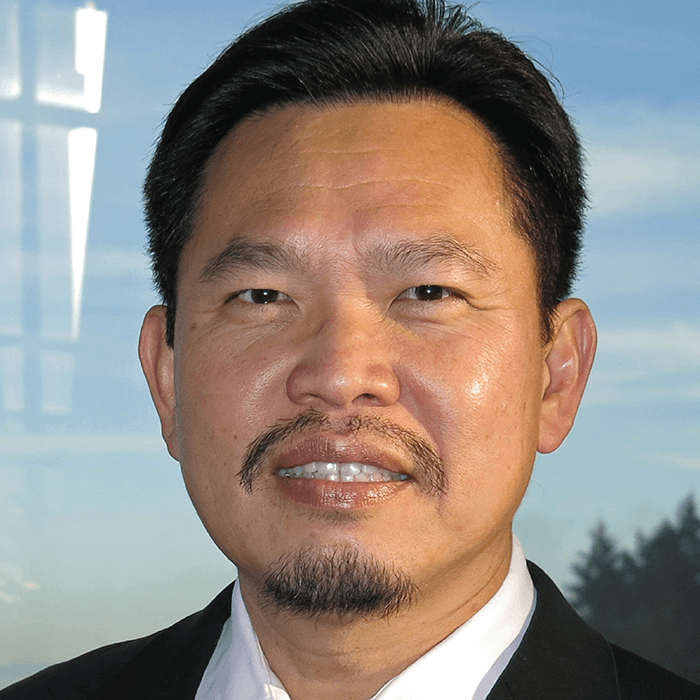
My first ophthalmic innovation idea was optical coherence tomography (OCT), developed over 30 years ago, when I was a MD/PhD candidate at the Harvard Medical School and Massachusetts Institute of Technology (MIT), Cambridge, Massachusetts, US. At the time, I wasn’t focusing specifically on ophthalmology, but having looked at several applications, my team saw OCT as likely to make a difference in retinal imaging because OCT has the requisite axial resolution to delineate fine retinal layers. This simple reasoning based on fundamentals turned out to be true – OCT is now the most commonly used ophthalmic imaging modality. This initial success gave me confidence to pursue further innovations and entrepreneurial projects.
My work on OCT mainly involved developing the original prototypes and doing the initial ex vivo experiments to demonstrate imaging. My PhD supervisor, James Fujimoto, Professor of Electrical Engineering at MIT, our engineering partner, Eric Swanson (then Head of Optical Communications at MIT Lincoln Laboratory), and the retina specialist who first used it clinically, Carmen Puliafito, were the main people involved in setting up the start-up company to develop and market OCT. The first patent that we filed included both time-domain and swept-source OCT technologies. We got a great team for our first clinical demonstrations and generated interest from quite a few companies. Eventually, it was picked up by Humphrey, which was then acquired by Zeiss.
Going it alone or in good company
I have partnered with both fellow academic researchers and companies and firmly believe that finding the right partners is the key to success. After my clinical training, I found my first faculty position at the Cleveland Clinic, where I met up again with Joseph A. Izatt, who also trained with Professor Fujimoto and was important in the development of the first clinical OCT system. Joe was then Assistant Professor of Biomedical Engineering at Case Western Reserve University in Cleveland, Ohio. Joe and I partnered to develop anterior segment OCT using the high-speed time-domain OCT engine developed in his laboratory. I then worked with Zeiss for a number of years to develop the first clinical anterior segment OCT product. I have also been a long-term partner with Optovue – first as a scientific advisor in 2006 and then over many year as collaborative research partners. This has been important for the commercialization of retina, cornea, and glaucoma analytics software developed in our laboratory. The collaborative relationship with Optovue helped our laboratory quickly commercialize OCT angiography technologies in the recent decade through university technology licensing.
One company that I started myself in 2011 is GoCheck Kids – a smartphone flash photography-based technology used to detect refractive error and amblyopia risk factor in preschool children. I ran the company as its CEO for a couple of years and then found a full-time CEO and venture capital to run it. GoCheck Kids is now widely used by pediatricians and has already screened more than five million children. More recently, I have set up another start-up company to develop laser thermal conjunctivoplasty with clinical and technology partners. As you can see, I’m interested in any clinical applications of optics and lasers, whether for diagnostic imaging or treatment. In all of these ventures, successful technology transfer from university to industry relies on partnership between technologists, clinicians, and business people.

Who can help
Over time, I have seen many universities become more sophisticated when it comes to developing and licensing new technologies. I was lucky to have started at MIT, which has been leading the way with its strong technology licensing office. My current institution, the Oregon Health and Science University, also has a strong and growing technology licensing and business development office.
When I embarked on my first entrepreneurial venture in 2011, I spent a lot of unfruitful time talking to local angel and venture investors who were not particularly knowledgeable of the product area. Eventually we were able to find the necessary funding from Silicon Valley investors with expertise in digital health and ophthalmology. I believe finding knowledgeable investors is very important because they can ask the right questions, understand the answers, give strategic advice, invest for the appropriate time frame, and make introductions to the right people to grow the company. These people may include the future company CEO, developers, marketers, and exit partners.
So for me, finding people with the right mix of expertise and building a team is probably the hardest and most time-consuming part of the technology translation and commercialization process. Clinicians are busy and those who are willing to pioneer new technologies in their clinical practice are true gems. Researchers thrive on credit and attributions. They generally don’t want to work on other people’s ideas, so it is important to generously acknowledge additional ideas, improvements, problem solving, and implementation steps that are contributed by your partners. It is easier to get things done if you are willing to give away most of the credit to your invention. It is better to have a small part of a big pie than to have 100 percent of an unrealized idea.
The ones that didn’t work… yet
More than two decades ago, I patented ideas to improve laser thermal keratoplasty for the treatment of astigmatism and keratoconus, but never managed to secure funding for commercialization. In retrospect this was fortuitous as clinical results obtained by others showed the durability of this general approach to be poor. I am still interested in laser thermal treatments and have recently started a company working on laser thermal conjunctivoplasty. About 15 years ago, my group developed a Doppler OCT method to measure total retinal blood flow and published several articles that contributed to the understanding of retinal diseases and glaucoma, but it was not accurate enough for clinical applications. We quickly transitioned to the development of OCT angiography, which we commercialized through technology licensing and did achieve widespread clinical use. I have not given up on Doppler OCT – new approaches will enable more accurate flow velocity and volume measurements that I believe have several applications. So, even “failed” ideas do not completely die but are waiting for the technology to mature and the right teams to form to be reincarnated in different clinical applications.
Innovators and innovations I admire
Mark S. Blumenkranz, Director Emeritus of the Stanford Byers Eye Institute in Palo Alto, California, US, is very good at matching technology to ophthalmic needs. He started a series of companies that led to clinically useful products. I admire his entrepreneurial chops. I have found Theo Seiler’s idea of corneal collagen cross-linking to be highly creative because it arose at the intersection of widely divergent fields, and it has made such a big difference in the treatment of keratoconus. Similarly, the light adjustable lens now marketed by RxSight is a very unobvious synthesis of innovations in both material science and ophthalmology. Matching technological and clinical insights is not common, and I admire it greatly.
